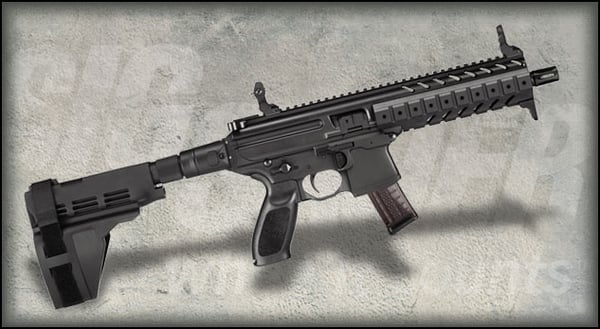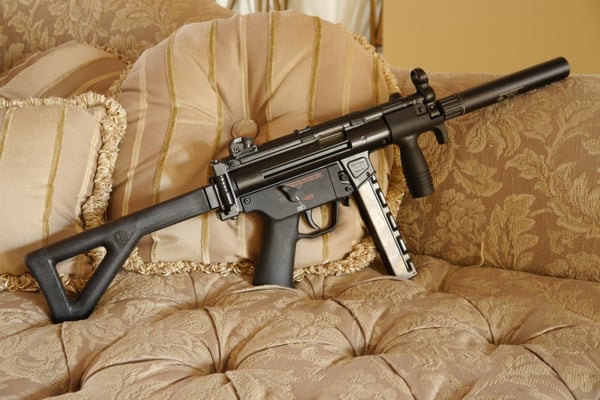Gun Review: SIG SAUER MPX Pistol
The SIG SAUER MPX might be the most anticipated new "rifle" among TTAG's readers.
Sight unseen in the civilian market, they awarded it the highest honor naming it 2014's Best New Rifle. Wanting to avoid the same kind of kerfuffle that surrounded the Remington R51 launch, we chose not to review the gun based on pre-production models and instead waited until the production version was available. Thanks to our friends at SIG SAUER we here at TTAG were given exclusive access to the first ever production MPX, as well as full access to their team's collective knowledge and expertise. So, does the finished product live up to the hype? . . .
Let's start with a little overview of the history behind the MPX.
There's no doubt in anyone's mind that the MP5 is the best-selling pistol caliber SMG in history.
The gun is iconic, used by military and law enforcement agencies worldwide. Heck, back in the 1980s you couldn't swing a dead cat without running into a movie or TV show where the gun was being used in some manner. It's just the epitome of cool.
While the appearance of the MP5 is a timeless classic, fifty years on the actual mechanics of the gun are starting to show their age. Stamped and welded receivers are no longer the state of the art design feature they once were. And roller delayed blowback is cool, but there are some major issues when switching between projectile weights that impact the longevity and reliability of the system. With the aging MP5 stockpiles of the world becoming more and more expensive to service, SIG SAUER wanted to develop a replacement weapon system that filled the same role but was easier to use and maintain. Their solution: the MPX.
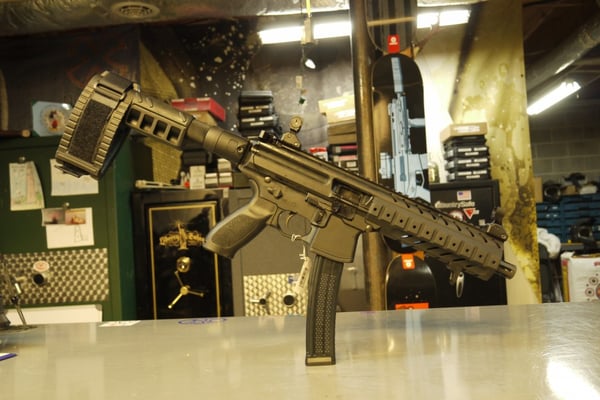
The overall appearance of the MPX might seem familiar.
That's because it was designed to mimic the most popular firearms platform in the world. Just about every law enforcement or military organization in the modern world uses some derivative of the AR-15 / M-16 design, and even if the design is different, the manual of arms is mostly the same.
The side-mounted bolt catch, AR style safety, and push-button magazine release are staples of every modern infantry weapon design, and in an effort to keep the training as simple as possible they incorporated these same controls into the MPX. In short, if you can run an AR-15 or M-16, you can run an MPX.
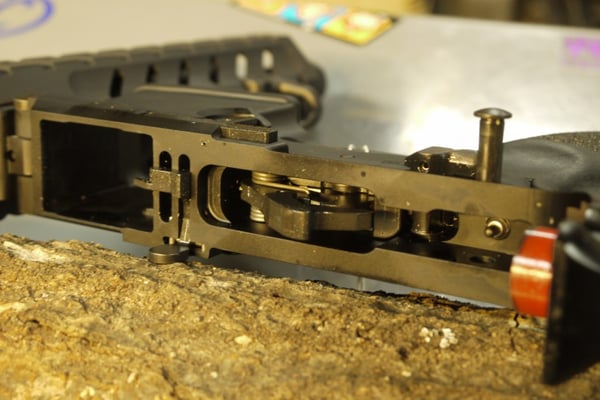
That design concept goes more than skin deep.
Not only is the AR-based training compatible with the MPX, but some of the parts are as well. Instead of re-designing a new trigger, the MPX takes a standard AR-15 trigger pack -- that's good, because the trigger it ships with is a terrible standard MILSPEC-style trigger. Whatever your favorite rifle trigger may be, it will comfortably fit in the MPX and let you have that same trigger pull on your rifle and your PDW.
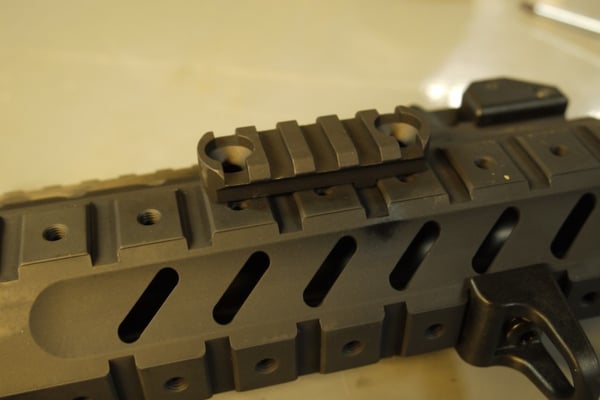
Along the top of the rifle is a full-length Picatinny rail, which is great for mounting optics and other accessories. As it comes from the factory, there will be a set of flip-up iron sights but you're probably going to want to replace those with something better like a red dot.
The forend for the first run of MPX firearms will use this SIG-specific attachment system, which is unique to the SIG SAUER line of guns. Starting in Q2, they will also be available with standard Keymod forends as well (~$100 as a replacement part), and carbon fiber versions, too (~$300). All guns will ship with a handstop and two rail sections that fit the wonky attachment system, by the way.
As for handguard lengths, there will be a 4" option for the "MPX-K" version, a 8" handguard for the 8" pistol, and a 10" handguard for the 16" rifle. I might actually recommend getting a replacement 10" handguard for the 8" pistol for those who own pistol silencers, as the handguards are big enough for a typical silencer to fit underneath. Or, heck, get a 4" barrel and a 10" handguard for maximum rail space and minimum overall length. That would be pretty awesome.
The grip is also interchangeable with the AR-15, but that's where the similarities stop.
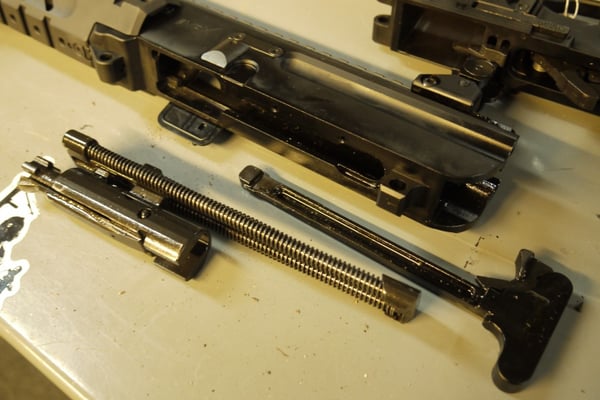
The bolt and bolt carrier are similar to the AR-15 system in that it uses a cam-based locking mechanism and a series of lugs around the bolt face to lock the breech, but how it moves about is very different. Where an AR-15 has the recoil system located in the stock, the MPX uses a recoil system that's housed completely within the upper receiver.
The bolt carrier group is attached to a set of springs, which recoil against the rear of the receiver and push the bolt back into battery. This system allows the gun to operate normally, even when the stock (and/or brace) is folded, and eliminates some of the weight of the gun by chopping down the overall length of the bolt carrier. In addition, the lowest lug on the bolt face has been extended to ensure that the bolt reliably picks up the next round from the magazine.
Oh, and there's a rubber dealie on the rear of the lower receiver to keep the metal gubbins from beating themselves to death. Which is nice.
The upper receiver has been changed as well. Not only has it been re-designed to take the new recoil system, but the upper has been reinforced to take the repeated stress of full auto fire. The all-aluminum upper has a steel insert where the bolt locks up, adding extra strength and durability to the upper to resist wear as the cam pin rotates during the locking and unlocking phases.
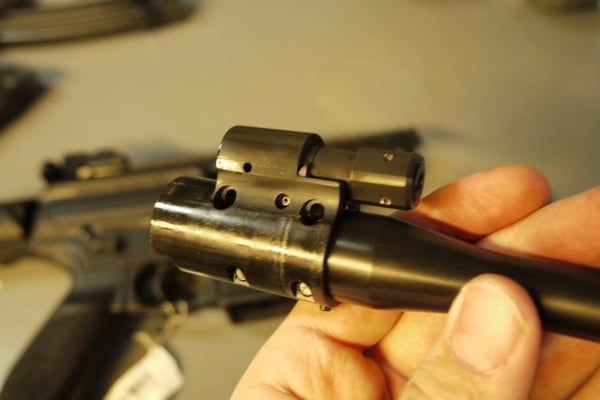
Instead of a direct impingement system like the AR-15 or a blowback system like the MP5 and CZ Scorpion Evo 3 S1, the MPX uses a short stroke piston system that's fixed to the barrel. Kinda like the M1 Carbine, actually. That piston system keeps the extremely dirty pistol caliber gasses contained mostly within the barrel, which keeps the receiver much cleaner than with the other methods.
It also makes the gun more reliable, as the gun is no longer depending on friction or tuned springs to cycle properly. Also, since the gas required to cycle the action will change with different barrel lengths, fixing the gas system to the barrel allows for a properly tuned gas plug to be issued straight from the factory instead of needing to mess around with your gun at the user level.
Did I say barrel change? Yeah, barrel change.
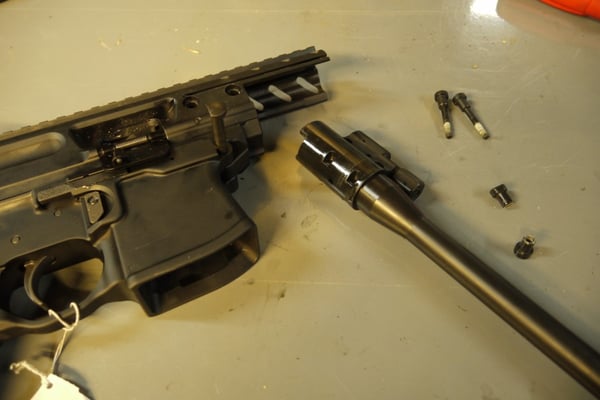
The barrels on the MPX are designed to be easily removed and changed out. Remove the handguard (take out the front takedown pin and they pull straight off) and then un-screw two small screws and the barrel comes straight out. SIG SAUER says that there will be three barrel lengths available: 4.5 inches, 8 inches, and 16 inches. The ability to swap from one barrel length to another depending on what you want to do is major, and will be even more of a benefit when the .40 S&W and .357 SIG conversion kits come in.
Let's bring it down for a second off the hype train and have some real talk about this specific production civilian MPX.
The gun has been delayed for months due to an engineering issue that has been resolved for 9mm but not quite yet finished for everything else. The decision on SIG SAUER's part is that rather than keeping the gun on hold indefinitely, they have decided to release the "Version 1" of the MPX -- available only in 9mm with no guarantee that 40 S&W and .357 SIG will ever work in it -- and have a "Version 2" available sometime next year with all the bells and whistles. They hope to be able to provide a conversion kit to get the "Version 1" MPXes up to the "Version 2" caliber change spec, but again there's no guarantee.
But really, for anyone thinking of buying one...
Did you actually want to shoot anything other than 9mm? Neither did I. And in the meantime, quick barrel length changes are cool for those planning on filing a Form 1 for their MPX.
One last thing about the barrel is the threading. Instead of using a normal thread pitch, SIG SAUER in their typical SIG SAUER way decided to use a 13.5x1 metric left hand thread pitch for their barrels. This means that normal flash hiders and muzzle devices will not fit, which is both good and bad. It's good because you won't be tempted to put a 5.56 muzzle brake on the 9mm (~.38 caliber) barrel, but it's bad because your silencers and associated awesomeness will need a custom thread pitch adapter to properly mount. For those like myself and Jeremy S. who own a Mystic X this is as simple as calling up Liberty Suppressors and asking them to cut us a custom mount, but if your can is a fixed thread version then this could be an issue.
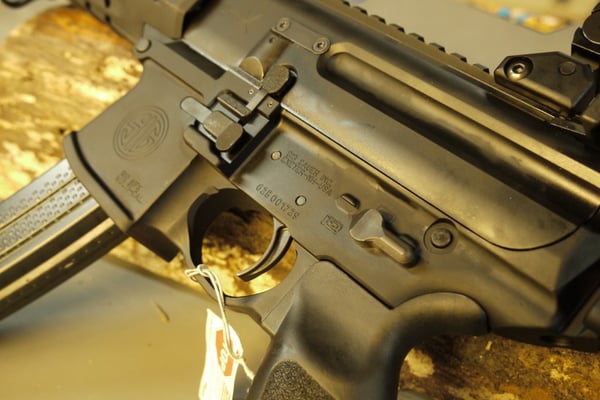
Back to the external controls on the gun, everything is fully ambidextrous.
There's a bolt release and magazine release located both on the left and right side of the gun, and the safety selector is ambi as well.
The receiver is cut to allow their nifty collapsible stock to be used on the gun, but you don't have to use it. The rear of the MPX has a Picatinny rail cut into it, allowing you to mount basically whatever you want. The pistol version will come from the SIG SAUER with either a pistol arm brace on a side-swinging knuckle, or just a plain Picatinny rail on the rear. There's also a NFA version for those who don't want to engrave their MPXes, FYI.
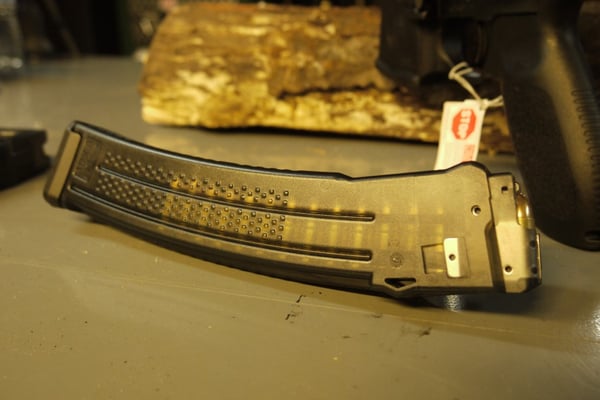
The magazines have been custom designed by Lancer to actually work. Most engineers I talk to say that the key to firearms design is to find a magazine that works and then design a gun around it, and SIG SAUER seems to have done just that. SIG SAUER isn't a magazine company, so they asked the best in the business to make it happen and the result is not only functional but beautiful. The guns will ship with one magazine, and more will be available shortly in varying lengths and capacities.
Price on new replacement magazines? $55 each.
Expensive, but this is the only gun that takes them (for now), and as more people buy the gun the price should come down as well. Hopefully.
Disassembly of the gun is easy and painless. Pull a few pins and the whole thing comes apart, even the handguards. The whole thing is very easy to clean and maintain, and replacing parts is a snap.
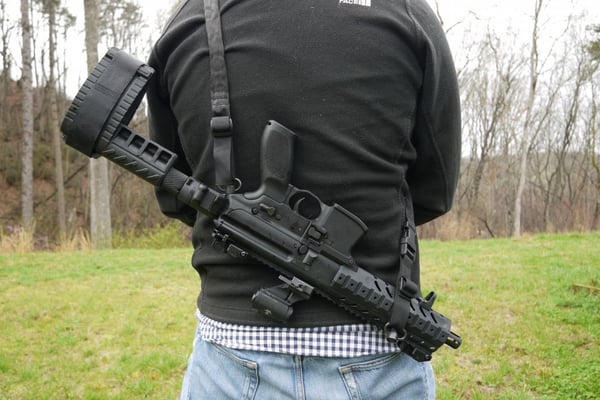
The gun looks awesome, has some killer features, and seems to be well built, but the real test is whether the gun runs out in the real world. To find out we took the MPX out into a wet and cold Georgia morning to do some accuracy and reliability testing.
The R&D guys say that Aguila ammunition won't run in the gun, but we fed it a steady diet of nothing but Aguila for a little bit and the gun didn't even hiccup. In fact, just like the pre-production MPX that we've been playing with for months, the gun ran without a single issue. The only problem I found with the MPX was that unmistakably terrible stock trigger. To be fair, the gun is designed as a close range PDW, but still a better trigger would be appreciated.
Even with that trigger, though, accuracy is pretty nice.
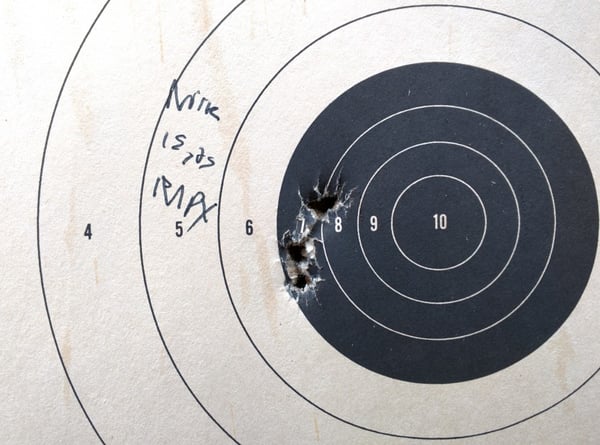
This target was fired from 15 yards, and for an 8 inch pistol caliber carbine that's pretty darn good. More accurate than the CZ Scorpion Evo 3 S1 pistol to be sure. Since the majority of the variability is in the vertical component rather than the horizontal, I get the feeling that the ammunition (Federal 115 grain standard ammo) is to blame, and the gun is capable of much better accuracy with better ammo. Even as-is, though, it put all five rounds practically through the same hole.
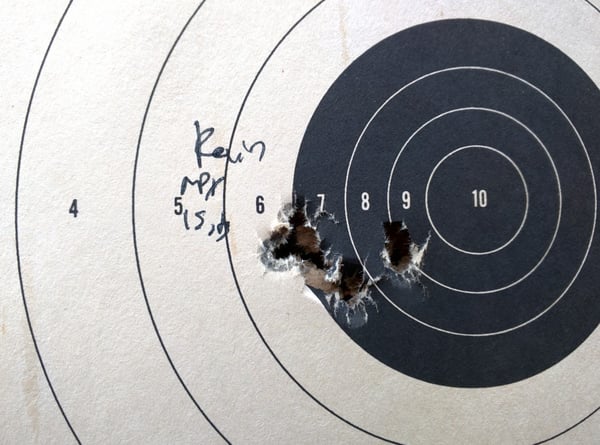
Kevin Brittingham tried as well, but his group wasn't as impressive. And yes, I'm posting this just to poke fun at his marksmanship and for no other purpose.
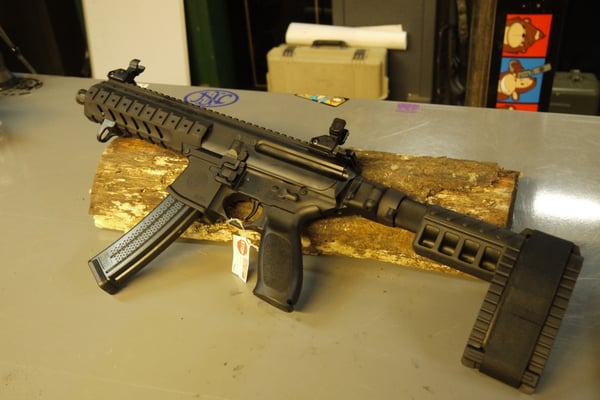
The gun looks great, shoots great, and feels great.
It meets all of the expectations that I had for it. So let's talk about the use case, price, and how it stacks up against the competition.
The biggest question people are going to ask is what good a pistol caliber carbine really is. To me, this is pretty much the perfect home defense gun. I'm a strong believer that a full-length rifle is pretty much the worst choice for a home defense firearm. The reason is that the weight of the gun and the length of the barrel make it awkward and heavy to maneuver in the confines of a home or apartment. Try holding your rifle in one hand aimed at your bedroom door and a cell phone in the other while trying to dial 911 and you'll see how difficult that can be. The compact form factor of the MPX eliminates nearly all of those concerns, since the shorter arm makes the weight much easier to handle.

While home defense use might be the main reason for some to buy the gun, the biggest reason is going to be the cool factor. Everyone and their brother own an AR-15 these days, and while having the coolest AR-15 on the range is nice, what's even cooler is to have something legitimately different. The MPX is an absolute blast to shoot. There's no doubt that if you show up with an MPX rather than "just another AR-15" you're going to be a popular guy.
Finally, for those who just like to shoot, the 9mm cartridge is a pretty darn good choice.
The prices on 5.56 NATO have been fluctuating wildly over the last few years, but no one has seriously presented any proposals to ban standard handgun ammunition. Generally, 9mm prices stay pretty steady and fairly low, which means that even when the next Evil Black Rifle (TM) ban is inevitably proposed, you'll still be able to find something to shoot.
The pistol versions of the gun will run $1,648 with the brace and attachment and $1,378 without the brace. That's MSRP, not street price, which will be considerably lower. There are two competitors for the same market, and I'd like to tackle each individually.
The obvious competition is the POF-5.
The Pakistani-made semi-auto H&K MP5 pistol is a 100% officially licensed copy of the original, and works identically to the real deal. It has all the same features, takes all the same parts, and looks factory fresh. Compared to the MPX, the gun is decidedly out of date -- stamped and welded sheet metal receiver, old style action, no attachment points for accessories, and old magazines. The gun clocks in at $1,400+ retail (NOT MSRP) without the brace and $275 more with a brace, so already the retail price of the gun is higher than the MSRP of the MPX. In short, there really isn't anything to recommend the POF-5 over the MPX from usability to price. The only place where it has the MPX beat is that MP5 magazines are easier to find, but not necessarily less expensive.
The newest entry into the market is the new CZ Scorpion. It does all the same things that the MPX does, but with a little less swagger. Instead of aluminum and steel, the Scorpion is mostly plastic. Instead of a proper gas system, the Scorpion uses a heavy blowback action. And while the MPX is svelte and ergonomic, the Scorpion isn't exactly the most comfortable thing to hold. But it works, and for $849 MSRP it works for a lot less money. Just like choosing between a Ford and a BMW, you can often get similar specs at a lower price, but the fit and finish definitely won't be in the same solar system.
I like the MPX. I've liked it since the first day I saw it. And now, if you'll excuse me for a moment, I'm going to go buy one.
Specifications: SIG SAUER MPX Pistol
Caliber: 9mm
Action: Semi-auto
Barrel: 8"
Weight: 6.1 lbs
Length: 26.37 Inches
Magazine: Two 30-round magazines included
MSRP: $1,648 with brace, $1,378 without
Ratings (out of five stars):
Accuracy: * * * * *
For an 8" barrel pistol caliber carbine, this is pretty awesome.
Ergonomics: * * * * *
Everything about this gun feels perfect in your hands.
Reliability: * * * * *
No issues. We fired hundreds of rounds through the production guns and thousands of rounds through the pre-production versions without a single issue.
Customization: * * * * *
The bolt and charging handle can't be easily swapped, but everything else is up for grabs. New stock? New barrel? New trigger? Why not?
Overall: * * * * 1/2
I'm knocking a half a star off for the God-awful trigger, the proprietary accessory mounting system on the handguards, and the whole "Version 1" issue. But even so, on its own merits, this is a fantastic firearm.



